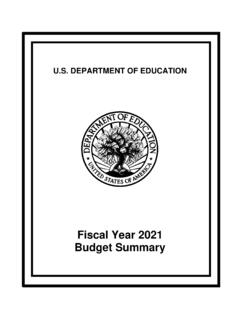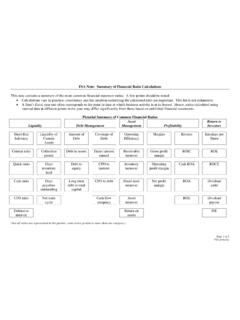Transcription of Costs of Debt and Equity Funds for Business: Trends and ...
1 This PDF is a selection from an out-of-print volume from the NationalBureau of Economic ResearchVolume Title: Conference on Research in Business FinanceVolume Author/Editor: Universities-National BureauVolume Publisher: NBERV olume ISBN: 0-87014-194-5 Volume URL: Date: 1952 Chapter Title: Costs of debt and Equity Funds for Business: Trends andProblems of MeasurementChapter Author: David DurandChapter URL: pages in book: (p. 215 - 262) Costs OF debt AND Equity Funds FOR Business: Trends AND PROBLEMS OF MEASUREMENTDAVID DURANDN ational Bureau of Economic ResearchIt does not seem feasible at this timeto present a paper that will do justiceto the title, " Costs of debt and Equity Funds for Business: Trends andProblems of Measurement." To me this title implies a critical analysis ofavailable data, and concrete proposals for research.
2 The need for suchresearch is great. We have heard a great deal recently about an allegedshortage of Equity capital, and we have actually observed that many cor-porations finance expansion with cash retained from operations or byborrowing. This may mean, as some have argued, that the usual sourcesof Equity capital have dried up, but it may also mean that corporationsfind selling stock much less attractive, or perhaps more costly, than othermethods of financing. How, therefore, do the Costs of stock financing com-pare with the Costs of borrowing, or the Costs of retentions? When, if ever,do the Costs of financing discourage business expansion? And finally, doesthe tax structure have any effect on the Costs of financing?I shall deal solely with conceptual problems and, in doing this, ruth-lessly brush aside the practical details in hope of clarifying the basic we have, I believe, a rather rough notion of what we mean bythe cost of raising capital, this notion needs to be sharpened before it isapplicable for use in actual measurement.
3 Furthermore, the sharpeningprocess indicates that our conceptual groundwork is inadequate to dealwith many questions of investment and capital cost. Hence, the formula-tion of a working definition of capital cost necessitates reformulating a gooddeal of basic and generally accepted economic theory. But even if weachieve a satisfactory definition of cost and a sound basic theory, thepractical problems of actual measurement are going to be , a good theory should enable us to understand these problemsmuch better, even if it does not diminish them these problems of measuring capital Costs are much the same asthe problems that arise in trying to appraise the going concern value of a215216 RESEARCH IN BUSINESS FINANCE business enterprise is the general theme of this paper. Almost any method0' estimating Costs will, I believe, at least imply an evaluation of the com-mon stock of a corporation or the proprietor's interest in an unincorporatedbusiness.
4 That is, we can measure the Costs of capital about as accuratelyas we can measure the value of common stock, and any of us who think thatstock appraisal is a form of crystal gazing should prepare to includeresearch on the cost of capital the same going on with this argument, I wish to offer a general the past three months of intermittent work on this paper, I haverepeatedly had to revise my opinions, and I expect to have to revise themfurther in the ensuing three months. I do, of course, expect to stand by twogeneral principles: 1) Ourbasiceconomic theory needs revisions; 2)Security appraisal is the key to measuring the cost of capital. But thedetails of the argument are, like a timetable, subject to change withoutnotice. This paper is therefore a historical statement of the developmentof my ideas to , I wish to thank Martin W.
5 Davenport and Wilson F. Payne forcontributing a large number of ideas, some of them basic, and for aid informulating the CONSIDERATIONSA greatof our economic thinking is derived from a few fundamentalnotions concerning self-interest. The businessman is supposed to knowwhat is best for him and to act accordingly. From analyzing these self-seeking actions, we hope to derive a theory of economic behavior. Thispaper is conventional in accepting the principle of self-interest and apply-ing it to the problems of capital cost. If the businessman raises capital tofinance a venture, it must be in furtherance of his interests; and any defini-tion of the Costs of raising this capital must be consistent with this paper is unorthodox, however, in its conception of what actuallyconstitutes a businessman's best interest.
6 Instead of accepting the commondictum that the businessman's interest is to maximize his income, thispaper counters with the alternative proposal that the businessman shouldtry to maximize his wealth. This alternative has the advantage of greaterflexibility, and for this reason it avoids errors that may result from forcingthe principle of maximizing income on situations to which it is income vs. Maximizing investment ValueOne can attack the principle of maximizing income simply on the groundsthat mankind's motives transcend the pecuniary, and that these motivesaffect his behavior, even in the market place. But leaving these nonpecu- Costs OF debt AND Equity FUNDS217niary motives aside, one can also attack the principle of maximizing incomeon the ground that it is totally meaningless in any world in which incomeis expected to change.
7 Suppose, for example, that a businessman has twopossible ways to operate his business. Operation A promises him an annualreturn of $6,500 in perpetuity, and Operation B promises him $10,000 inperpetuity. The principle of maximizing incomewell in this businessman will certainly choose Operation B with its higher income(since nonpecuniary niotives are ruled out).But suppose this businessman has another alternative OperationC whichgets underway slowly and thus promises him $7,000 the first year,$9,000 the second year, and $10,500 thereafter. The principle of maximiz-ing income tells us that Operation C is preferable to Operation A becausethe income from Operation C is certainly larger than that from Opera-tion A. But the principle cannot tell us whether Operation C is also prefer-able to Operation B.
8 Is the combination of $7,000, $9,000, and $10,500thereafter greater or less than $10,000 in perpetuity? This difficulty canbe readily resolved provided a discount rate or other index of time prefer-ence is available, and provided, further, that the principle of maximizingincome is appropriately table below shows the discounted, or present, value of incomeunder Operations B and C at four arbitrary rates of discount (standardcompound interest tables were used). Thus, Operation B is preferable forrates of 10 percent and above, whereas Operation C is preferable for ratesof 9 percent and VALUED iscountOperationOperationDifferenceRateB C( )7%$142,857$144,514$1,6578125,000125,832 8329111,111111,31420310100,000 99,711 289 Toeffect this simple solution, it was necessary to modify the principleof maximizing income.
9 The statement, "The businessman tries to maximizehis income," was changed to read, "The businessman tries to maximize thediscounted value of his future income." Of course, some variations interminology are possible within the revised statement; and, in fact, thispaper will henceforth use the term "investment value" to mean the dis-counted value of an expected income revision is more than mere verbiage. The shift from maximizationof income to maximization of discounted value has important implications1 Amongthe possible alternatives are "going-concern value" and "intrinsic value."Some security analysts specifically think of intrinsic value as a sum of discountedfuture income payments; others are less IN BUSINESS FINANCEfor the measurement of Costs and the analysis of investment problems. Itemphasizes the basic importance of appraisal and security analysis inmolding business decisions.
10 How can the businessman go about maximiz-ing investment value without developing a system of appraisal that issuitable, to him at least?Economic theory has used, the principle of maximizing income todemonstrate that business expansion will proceed until the marginal returnon capital equals the rate of interest. A brief resum of the argument isillustrated in Chart 1. Here the marginal return curve represents the rateof return on successive small increments to a businessman's assets. Thecurve always slopes downward because the businessman is supposed tomake his successive small investments in order of profitability. Since themarginal return represents the net return before interest, the distancebetween this curve and the horizontal line representing the interest rate isthe marginal net return after interest.














